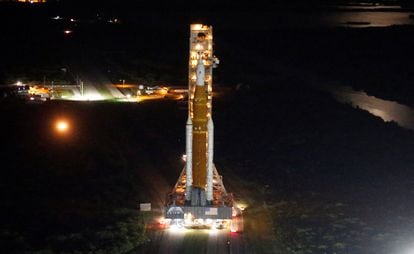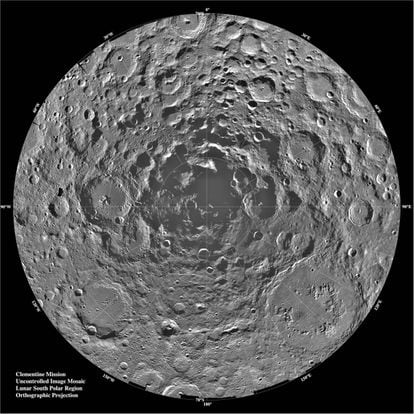The dream of getting a woman to step on the surface of the Moon is seven decades old, the time that has passed since NASA decided to cancel its female astronaut program due to sexism. Now, it is a dream that is beginning to take shape thanks to the conviction with which the space agency is working on it by 2025. The Artemis program, in which Europe also participates, has already designated the possible territories in which humans will land on the moon the earth satellite for the first time since the mission left apollo 17in December 1972. The lunar south pole, with its dark craters of perpetual ice, is the place chosen for that small step for a woman, but a great leap for the (other half of) humanity.
NASA has today put thirteen crosses on the lunar treasure map: they are the candidate sites for the moon landing in 2025, if all goes according to plan. Each of those marked regions at the south pole measures approximately 15 kilometers on a side, and within them, the landing site is located to the nearest 100 meters.
“Selecting these regions means we are one giant step closer to returning humans to the Moon for the first time since the Apollo program,” said Mark Kirasich, deputy administrator for NASA’s Artemis Development Division. And he adds, in a note from the agency: “When we do, it will be unlike any previous mission, as astronauts will venture into dark areas previously unexplored by humans and lay the groundwork for future long-term stays.”
NASA identified the following candidate regions for the Artemis III landing: Faustini Rim A; Peak near Shackleton; Connection crest; Extension of the connecting ridge; Gerlache edge 1; Gerlache edge 2; Gerlache-Kocher massif; Haworth; Malapert Massif; Leibnitz Beta Plateau; Noble Edge 1; Noble Edge 2; and Amundsen’s edge.

Each of those regions was assessed using data from NASA’s Lunar Reconnaissance Orbiter (LRO), as well as decades of publications and findings, to assess terrain, communications, and lighting conditions, as well as the ability to meet scientific objectives. From now on, a debate will begin within the scientific community, assures the space agency, to decide in the coming months which is the region with the most merits to receive the next human mission to the Moon.
“Several of the proposed sites in these regions are located in some of the oldest parts of the Moon and, along with the permanently shadowed regions, offer an opportunity to learn about the Moon’s history through previously unstudied lunar materials.” says Sarah Noble, Artemis lunar science lead for NASA’s Planetary Science Division.
cold dark shadows
Why the south pole? Science, logistics and resources. This area of the Moon is little known, but it is known that it has large accumulations of frozen water, which could be very useful when considering a lunar base that would serve as a springboard to Mars, both for astronauts to drink and for manufacture hydrogen-based rocket fuel. “The high mountains of the region cast dark shadows and the deep craters protect the perpetual darkness of its abysses,” explains NASA.
Some of these craters harbor permanently shadowed regions that have not seen sunlight in billions of years with temperatures as low as -203°C (-334°F). It is one of the coldest regions of our solar system and no previous mission has explored it, only with remote sensing instruments.
In addition, the space agency assures, quality astronomical observations can be made from there: “The unique characteristics of this region promise unprecedented scientific discoveries in deep space that could help us learn about our place in the universe and venture further into the universe. Solar system”. Philippe Deloo, a NASA engineer, recently explained: “We are going to deploy all our capabilities to explore the South Pole of the Moon, which is of enormous geological interest and has great potential for commercial exploitation of minerals.”
Three steps and one jump
The first step of this program is already beginning to take place. The mission Artemis I It is already on the launch pad at Cape Canaveral (Florida, USA) for its launch on August 29, if the weather is good and everything goes according to plan. This first voyage of the ship Orionpropelled by the most powerful rocket in the world (SLS, 65 meters high), will last approximately one month, and will have dummies as the only passengers, which will serve to test the conditions that astronauts will experience.

In this case, the spacecraft will only orbit the satellite, but reaching farther into space than a spacecraft intended to be manned has ever gone before. The next step would be given by the mission Artemis II in 2024, according to NASA’s current plan, which would make the same route, but this time with four astronauts on board. If there are no trips, in the year 2025 the mission would be launched towards the Moon Artemis IIIwhich will take “the first woman and the first person of color to the Moon, paving the way for a long-term lunar presence and serving as a springboard to send astronauts to Mars,” according to the space agency.
The flight test of Artemis I will deploy two small CubeSats to advance the search for lunar resources. And a water detection rover (VIPER) will also be sent, on the first resource mapping mission on another world. VIPER is scheduled to land near the Nobile region, one of thirteen now selected for landing astronauts.
The choice of the dark territories of the lunar south pole has an added risk: when the spacecraft touched down, the astronauts of the Apollo program had a clear view of the Moon below them, illuminated by the Sun, “but the astronauts Artemis will have an interrupted view, with long dark shadows obscuring important terrain features. However, they will feature preloaded maps that provide topographical details of robotic missions like LRO along with advanced training using technology that was not available to the Apollo crews.
You can follow MATTER in Facebook, Twitter and Instagramor sign up here to receive our weekly newsletter.
In one of these places a woman will set foot on the Moon for the first time | Science
& Latest News Update
In one of these places a woman will set foot on the Moon for the first time | Science
& More Live News
All this news that I have made and shared for you people, you will like it very much and in it we keep bringing topics for you people like every time so that you keep getting news information like trending topics and you It is our goal to be able to get
all kinds of news without going through us so that we can reach you the latest and best news for free so that you can move ahead further by getting the information of that news together with you. Later on, we will continue
to give information about more today world news update types of latest news through posts on our website so that you always keep moving forward in that news and whatever kind of information will be there, it will definitely be conveyed to you people.
In one of these places a woman will set foot on the Moon for the first time | Science
& More News Today
All this news that I have brought up to you or will be the most different and best news that you people are not going to get anywhere, along with the information Trending News, Breaking News, Health News, Science News, Sports News, Entertainment News, Technology News, Business News, World News of this made available to all of you so that you are always connected with the news, stay ahead in the matter and keep getting today news all types of news for free till today so that you can get the news by getting it. Always take two steps forward
Credit Goes To News Website – This Original Content Owner News Website . This Is Not My Content So If You Want To Read Original Content You Can Follow Below Links
